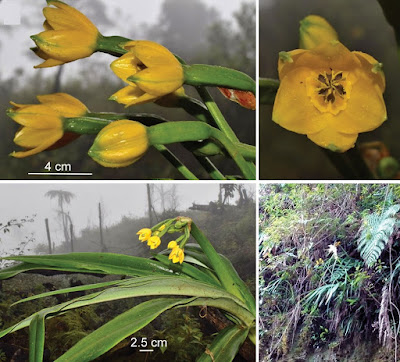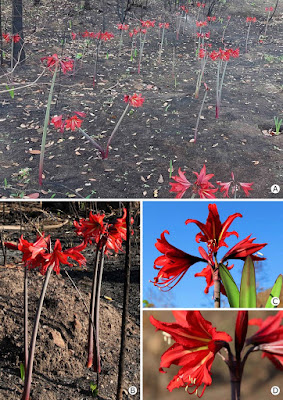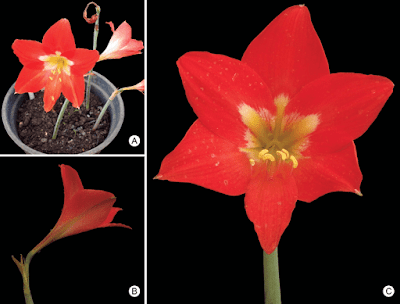 |
| Eithea lagopaivae Campos-Rocha & Dutilh |
Abstract
Eithea lagopaivae Campos-Rocha & Dutilh, sp. nov. is described as the second species of the formerly monotypic genus Eithea. It is characterized by a one flowered inflorescence, completely hollow scape, white or lightly magenta-striated flower that is enclosed by spathe bracts fused for more than the lower fifth of its length. Comments on its range, habitat, phenology, as well as photographs and illustrations are provided. In addition, a distribution map and an identification key for the two species of the genus are presented and anatomical and ecological differences compared. Known by only two small populations exposed to several types of threats and without any guarantee of protection, E. lagopaivae is considered a Critically Endangered (CR) species.
Keywords: Anatomy, Asparagales, Endemism, Hippeastreae, São Paulo
Eithea lagopaivae Campos-Rocha & Dutilh, sp. nov.
Diagnosis: Eithea lagopaivae differs from E. blumenavia (Figure 3) by its smaller size, one flowered inflorescence (vs. 2–6, very rarely 1), a fully hollow scape (vs. solid in the lower fifth), terminated by spathe bracts fused for more than the lower fifth of their length (vs. free or fused up to the lower fifth), absence of bracteoles (vs. presence), white or only very lightly striated flowers (vs. strongly striated) and lateral and lower petals of similar width (vs. lateral petals up to twice the width of the lower).
Distribution, habitat and ecology: Eithea lagopaivae is known from only two small populations separated about 50 km, each composed of less than 50 individuals. The type population (Piracicaba) occurs in the understory of an abandoned Eucalyptus plantation, next to fragments of deciduous and semideciduous forest, where the Corumbataí river meets the Piracicaba river. The second is located in a small fragment of semideciduous forest, near the junction of the basins of the Piracicaba and Tietê rivers in the municipality of Tietê (Figure 4). Both fragments are located on gravelly soils of litholic limestone origin (Oliveira and Prado 1989). The region presents a well-defined seasonality, with total annual rainfall of 1230 mm and precipitation of 50 mm or less, for six months, during autumn and winter. During spring and summer, rainfall exceeds 100 mm for six months, reaching close to 250 mm in January (EMBRAPA 2003). Ants were observed removing elaiosomes from the seeds of E. lagopaivae in their natural habitat, indicating that these animals might be dispersal agents, as is known for Griffinia.
Etymology: The epithet is a tribute to Celso do Lago Paiva, environmental analyst at ICMBio, who has collected the plant for the first time and has dedicated his life to the study and conservation of the flora of Brazil.
Resumo: Eithea lagopaivae Campos-Rocha & Dutilh, sp. nov. é descrita como a segunda espécie do gênero previamente monotípico Eithea. Caracteriza-se por apresentar a inflorescência uniflora, escapo totalmente oco, flor alva ou com leves estrias magenta, protegida por brácteas espatáceas fundidas na base por mais de um quinto do seu comprimento. Comentários sobre a sua área de ocorrência, hábitat, dados de fenologia, fotografias e ilustrações são fornecidos. Adicionalmente, um mapa de distribuição e uma chave de identificação para as duas espécies do gênero são apresentados e suas diferenças anatômicas e ecológicas comparadas. Conhecida de apenas duas pequenas populações sujeitas a diversos tipos de ameaça e sem qualquer garantia de proteção, E. lagopaivae é considerada uma espécie Criticamente em Perigo (CR) de extinção.
Palavras-chave: Anatomia, Asparagales, Endemismo, Hippeastreae, São Paulo
Antonio Campos-Rocha, Alan William Meerow, Edimar Faria Menezes Lopes, João Semir, Juliana Lischka Sampaio Mayer and Julie Henriette Antoinette Dutilh. 2017. Eithea lagopaivae, A New Critically Endangered Species in the previously Monotypic Genus Eithea Ravenna (Amaryllidaceae). PhytoKeys. 85: 45-58. DOI: 10.3897/phytokeys.85.13369
---------------------------------------------------------------
روابط التحميل والمشاهدة، الروابط المباشرة للتحميل
او
شاهد هذا الفيديو القصير لطريقة التحميل البسيطة
كيف تحصل على مدونة جاهزة بآلاف المواضيع والمشاركات من هنا
شاهد قناة منتدى مدونات بلوجر جاهزة بألاف المواضيع والمشاركات على اليوتيوب لمزيد من الشرح من هنا
رابط مدونة منتدى مدونات بلوجر جاهزة بآلاف المواضيع والمشاركات في أي وقت حــــتى لو تم حذفها من هنا
شاهد صفحة منتدى مدونات بلوجر جاهزة بألاف المواضيع والمشاركات على الفيس بوك لمزيد من الشرح من هنا
شاهد صفحة منتدى مدونات بلوجر جاهزة بألاف المواضيع والمشاركات على الفيس بوك لمزيد من الشرح من هنا
تعرف على ترتيب مواضيع منتدى مدونات بلوجر جاهزة بآلاف المواضيع والمشاركات (حتى لا تختلط عليك الامور) من هنا
ملاحظة هامة: كل عمليات تنزيل، رفع، وتعديل المواضيع الجاهزة تتم بطريقة آلية، ونعتذر عن اي موضوع مخالف او مخل بالحياء مرفوع بالمدونات الجاهزة بآلاف المواضيع والمشاركات، ولكم ان تقوموا بحذف هذه المواضيع والمشاركات والطريقة بسيطة وسهلة. ــــــــــــــــــــــــــــــــــــــــــــــــــــــــــــــــــــــــــــــسلامـ.





















